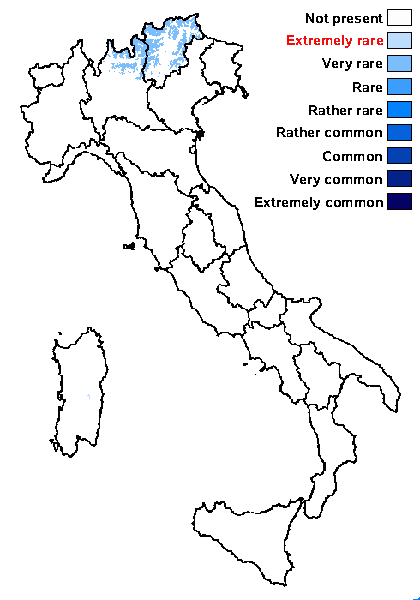Rinodina arnoldii H. Mayrhofer & Poelt
Bibl. Lichenol., 12: 54, 1979.
Synonyms:
Distribution: N - TAA (Nascimbene & al. 2022), Lomb. C - Sar (Nöske 2000).
Description: Thallus crustose, episubstratic, rather thick, continuous to usually rimose-areolate, dark grey-brown to dark brown, usually without a distinct prothallus, or partly with a black prothallus. Areoles 1-7 mm across, rugose, the marginal ones sometimes sublobulate. Apothecia at first cryptolecanorine to lecanorine, rapidly becoming pseudolecanorine, adnate to subsessile, abundant, up to 0.6(-1.2) mm across, with a flat to slightly convex, dark brown to black disc, and a thin, entire to crenate, finally excluded thalline margin. Exciple 10-15 µm thick, broadening in upper part; epithecium reddish brown; hymenium colourless, 70-110 µm high; paraphyses 2.5-3 µm thick in lower part, the apical cells 4-6 µm thick; hypothecium colourless, forming a stipe in lower part. Asci 8-spored, cylindrical-clavate, the K/I+ blue tholus penetrated by a faintly amyloid apical cushion with parallel or diverging flanks, the wall K/I-, surrounded by a K/I+ blue outer layer, Lecanora-type. Ascospores 1- septate, brown, ellipsoid, (13-)15-17(-20) x (7-)8-9(-11) µm, the torus absent of poorly developed, the wall warted, Milvina-type, some of them grading into the Pachysporaria-type; ascospore-ontogeny of type A (apical wall thickening after septum formation). Photobiont chlorococcoid. Spot tests: thallus and medulla K-, C-, KC-, P-, UV-. Chemistry: zeorin (traces).Note: on calciferous schists and sandstone near and above treeline. The Italian records need confirmation; for further details see Giralt & Llimona (1997).
Growth form: Crustose
Substrata: rocks
Photobiont: green algae other than Trentepohlia
Reproductive strategy: mainly sexual
Poorly known taxon in need of further study
Commonnes-rarity: (info)
Alpine belt: very rare
Subalpine belt: very rare
Oromediterranean belt: extremely rare
Montane belt: absent
Submediterranean belt: absent
Padanian area: absent
Humid submediterranean belt: absent
Humid mediterranean belt: absent
Dry mediterranean belt: absent

Predictive model
Growth form: Crustose
Substrata: rocks
Photobiont: green algae other than Trentepohlia
Reproductive strategy: mainly sexual
Poorly known taxon in need of further study
Commonnes-rarity: (info)
Alpine belt: very rare
Subalpine belt: very rare
Oromediterranean belt: extremely rare
Montane belt: absent
Submediterranean belt: absent
Padanian area: absent
Humid submediterranean belt: absent
Humid mediterranean belt: absent
Dry mediterranean belt: absent

Predictive model
 Index Fungorum
Index Fungorum
 GBIF
GBIF

